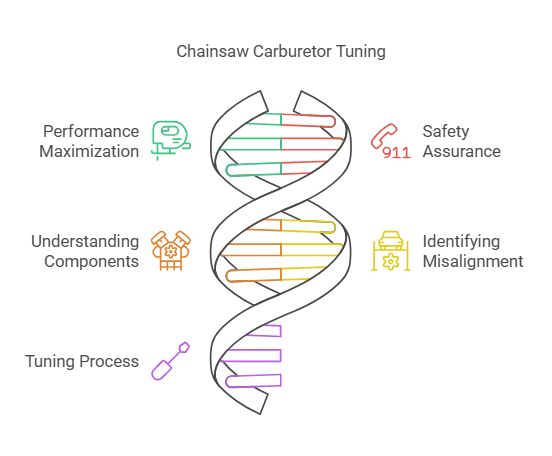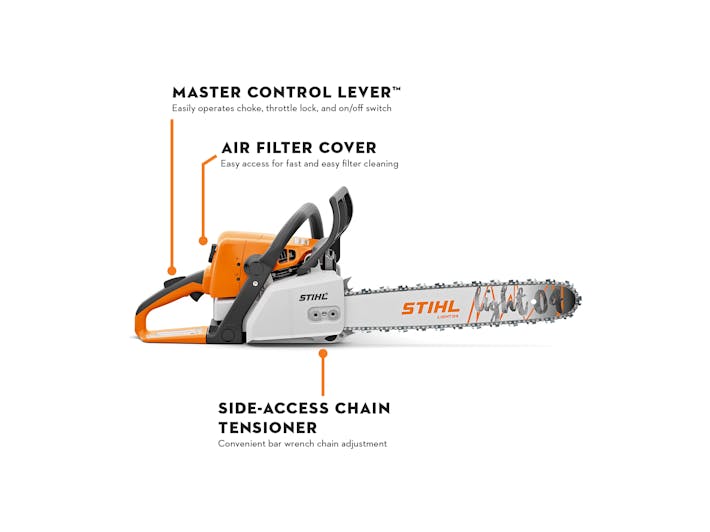To tune a chainsaw carburetor, adjust the low and high-speed screws while the chainsaw is running. When it comes to maintaining a chainsaw’s performance, one crucial task is tuning the carburetor.
By adjusting the low and high-speed screws while the chainsaw is running, you can maximize its efficiency and power output. Proper carburetor tuning ensures an optimal fuel-to-air ratio, enhancing the chainsaw’s performance and preventing engine damage. In this guide, we will provide you with step-by-step instructions on how to tune a chainsaw carburetor to achieve the best cutting performance.
So, let’s dive in and get started on tuning your chainsaw carburetor for optimal performance.
Importance Of Chainsaw Carburetor Tuning
Tuning the carburetor of your chainsaw is a crucial step that often gets overlooked. However, neglecting this important maintenance task can lead to a host of problems, including decreased performance and potential safety hazards. In this section, we will explore the reasons why tuning your chainsaw carburetor is essential for maximizing performance and ensuring safety.
Maximizing Performance
An optimally tuned chainsaw carburetor plays a significant role in maximizing the performance of your chainsaw. When the carburetor is properly adjusted, it ensures the engine is receiving the correct fuel-to-air ratio for efficient combustion. This means the saw will run smoothly, providing consistent power and cutting through wood effortlessly. By fine-tuning the carburetor, you can optimize the chainsaw’s performance, helping you tackle even the toughest cutting tasks with ease.
There are several benefits to achieving maximum performance through carburetor tuning:
- Increased Power: A well-tuned carburetor delivers a consistent flow of fuel to the engine, resulting in improved power output. This allows the chainsaw to cut through dense wood more easily, reducing strain on the engine and increasing productivity.
- Enhanced Fuel Efficiency: Proper carburetor tuning ensures that the engine is not running too rich or too lean, optimizing fuel consumption. With a finely tuned carburetor, you can maximize the chainsaw’s fuel efficiency, allowing you to work for longer periods without frequent refueling.
- Reduced Emissions: A properly adjusted carburetor promotes cleaner combustion, leading to reduced exhaust emissions. This not only benefits the environment but also ensures compliance with emissions regulations in your area.
Ensuring Safety
Aside from performance benefits, tuning the chainsaw carburetor is crucial for safety reasons. A poorly tuned carburetor can lead to unpredictable behavior and potential hazards, compromising the operator’s safety and increasing the risk of accidents.
Here are some safety implications of neglecting carburetor tuning:
- Unstable Engine Operation: If the carburetor is not properly tuned, the engine may run erratically, leading to sudden stalls or inconsistent performance. This can be dangerous, especially when working on uneven terrain or at heights, where stability is critical.
- Inadequate Lubrication: A misadjusted carburetor can result in improper fuel delivery, leading to insufficient lubrication of engine components. This can cause excessive wear and tear on critical parts, possibly leading to engine damage or failure.
- Increased Kickback Risk: A poorly running chainsaw due to an improperly tuned carburetor can cause more frequent kickback. Kickback is a sudden and violent reaction that occurs when the chainsaw’s guide bar touches an object or a pinched area, resulting in a dangerous recoil motion. Proper carburetor tuning helps maintain stability and reduces the risk of kickback accidents.
Taking the time to tune your chainsaw carburetor not only enhances performance but also ensures your safety during operation. It is an essential maintenance task that should be part of your regular chainsaw maintenance routine.

Credit: www.stihlusa.com
Understanding The Chainsaw Carburetor
To ensure your chainsaw operates efficiently, understanding the carburetor is crucial. Tuning the chainsaw carburetor involves adjusting the air and fuel mixture for optimal performance and smooth operation. Regularly maintaining and tuning the carburetor will keep your chainsaw running in top condition.
Key Components
The chainsaw carburetor is a vital component responsible for the engine’s performance. To tune the carburetor effectively, it is essential to understand its key components.
Here are the key components of a chainsaw carburetor:
- Fuel Metering System: This component regulates the amount of fuel mixed with air for combustion. It consists of an inlet needle, fuel screen, and metering diaphragm.
- Air Intake System: Responsible for drawing in the necessary air for combustion. Its components include an air filter, choke, and air intake manifold.
- Throttle System: Controls the fuel and air mixture flow rate. It consists of a throttle lever, throttle valve, and throttle diaphragm.
- Idle and High-Speed Screws: These screws allow for adjusting the amount of fuel delivered during idle and high-speed operations.
- Primer Bulb: Primarily used for starting the chainsaw by pumping fuel into the carburetor.
Functionality
A chainsaw carburetor functions by regulating the flow of fuel and air into the engine. Understanding its functionality is crucial for ensuring optimal performance.
Here’s how the chainsaw carburetor works:
- The fuel enters the carburetor through the fuel inlet and passes through the fuel screen, which filters out any debris or impurities.
- Using the fuel metering system, the carburetor mixes the fuel with the air in the desired ratio for efficient combustion.
- The air intake system draws in the required amount of air, adjusting the mixture’s richness or leanness based on the throttle position.
- The throttle system, operated by the throttle lever, controls the flow rate of the fuel and air mixture. When the throttle is opened, more fuel and air are allowed into the engine for increased power.
- The idle and high-speed screws adjust the fuel flow during idle and high-speed operations respectively, ensuring the chainsaw functions smoothly across different RPM ranges.
- The primer bulb aids in starting the chainsaw by enriching the mixture with fuel and delivering it directly to the combustion chamber.
Understanding the functionality of the chainsaw carburetor is crucial for effective tuning, allowing you to optimize the engine’s performance and ensure smooth operation.

Signs Of A Misaligned Carburetor
When operating a chainsaw, it’s crucial to recognize the signs of a misaligned carburetor to ensure optimal performance. Ignoring these signs can lead to poor engine performance and excessive fuel consumption, impacting the chainsaw’s operation and efficiency.
Poor Engine Performance
Misaligned carburetor can cause poor engine performance such as difficulty starting the chainsaw and rough idling. This can also result in uneven power delivery during operation, affecting the cutting efficiency and overall functionality of the chainsaw.
Excessive Fuel Consumption
An excessive fuel consumption is another sign of a misaligned carburetor. This can lead to increased fuel costs and reduced operating time, impacting the productivity of the chainsaw and causing inconvenience during use.
Step-by-step Carburetor Tuning Process
How to Tune a Chainsaw Carburetor Master the Saw’s Performance
.jfif)
Credit: www.alldadelawnmowers.com
Tips For Maintaining A Properly Tuned Carburetor
Proper maintenance of a chainsaw’s carburetor is essential for optimal performance. Here are some tips to tune a chainsaw carburetor to ensure smooth operation and efficient cutting power.
Regular Inspection
Regularly inspecting your chainsaw carburetor is crucial for maintaining its performance and longevity. By keeping a close eye on the condition of your carburetor, you can identify and address any potential issues before they become major problems.
Here are some key areas to focus on during your regular carburetor inspection:
- Check the air filter for any signs of dirt or debris that may be clogging it. A clean air filter ensures proper airflow, which is essential for efficient carburetor operation.
- Inspect the fuel lines for cracks or leaks. Damaged fuel lines can lead to fuel supply issues and affect the carburetor’s performance.
- Examine the carburetor for any signs of wear or damage. Look for loose or broken parts, as well as any buildup of dirt or residue that may be affecting its functionality.
- Ensure that the throttle mechanism is operating smoothly and without any sticking or hesitation. A properly functioning throttle is essential for accurate fuel and air mixture adjustments.
Proper Storage Practices
Properly storing your chainsaw can make a significant difference in maintaining a properly tuned carburetor. By following these storage practices, you can extend the life of your carburetor and improve its performance.
Consider the following tips for storing your chainsaw:
- Before storing, empty the fuel tank to prevent fuel from deteriorating and causing clogs or blockages in the carburetor.
- Clean the chainsaw thoroughly, removing any dirt, sawdust, or debris that may have accumulated during use. Pay close attention to the air filter and ensure it is clean and free from any obstructions.
- Apply a protective coating of oil or lubricant to the chainsaw’s metal components to prevent rust and corrosion during the storage period.
- Store the chainsaw in a clean and dry environment, preferably in a carrying case or protective cover.
By incorporating these regular inspection and proper storage practices into your chainsaw maintenance routine, you can ensure that your carburetor remains in peak condition. Following these tips will not only enhance your chainsaw’s performance but also extend its overall lifespan.

Credit: www.stihlusa.com
Frequently Asked Questions Of How To Tune A Chainsaw Carburetor
How Do You Adjust The H And L On A Chainsaw?
To adjust the H and L on a chainsaw, locate the screws labeled H (high) and L (low) on the carburetor. Turn the H screw clockwise to increase fuel flow for higher RPMs and counterclockwise to decrease. For lower RPMs, turn the L screw clockwise to increase fuel flow and counterclockwise to decrease.
How Do I Tune Up My Chainsaw?
To tune up your chainsaw, first clean the air filter and check the spark plug. Then, adjust the carburetor and sharpen the chain. Finally, lubricate the bar and chain. Regular maintenance ensures optimal performance.
What Causes A Chainsaw To Bog Down When Accelerating?
A chainsaw may bog down when accelerating due to a clogged air filter, improper fuel mixture, or a dull chain.
What Is The T Adjustment On A Chainsaw?
The T adjustment on a chainsaw allows you to fine-tune the tension of the chainsaw’s chain. It ensures optimal performance and helps prevent the chain from slipping off or becoming too tight. Adjusting the T is crucial for safe and efficient chainsaw operation.
Conclusion
Tuning a chainsaw carburetor is crucial for optimal performance. By following the steps outlined in this guide, you can ensure that your chainsaw operates efficiently and effectively. Regular maintenance and tuning will extend the lifespan of your equipment, saving you both time and money in the long run.
Happy sawing!

